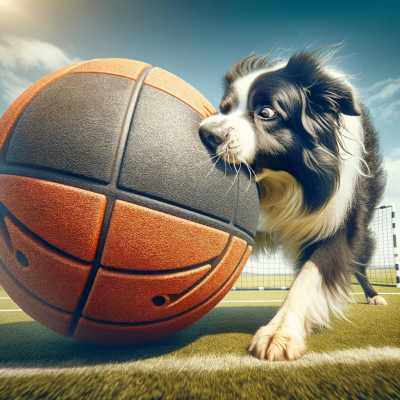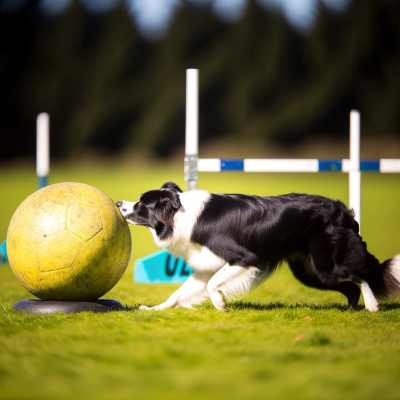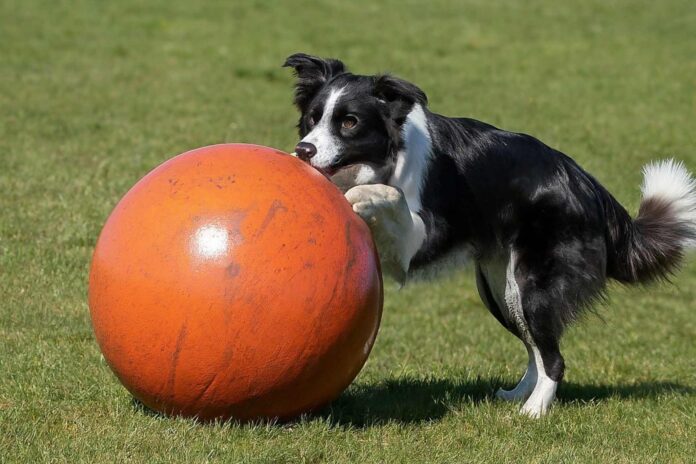Have you ever wondered how to tap into the untapped potential of your furry friend? Say hello to Treibball, the game-changing dog sport that’s all about mental stimulation and problem-solving.
Picture this: your dog, mastering the art of guiding balls into a goal with precision and strategy, all while having the time of their life.
Intrigued? You should be! In this comprehensive guide, we’ll unpack everything you need to know about Treibball, from its fascinating benefits to how you can get your pooch started on this thrilling journey.
Get ready to discover a whole new side to your canine companion.
Introduction to Treibball
Treibball, affectionately known as “urban herding,” stands out as a testament to the adaptability and intelligence of dogs across all breeds, extending beyond the conventional herding group to include a wide array of canine participants.
This sport, which made its debut in the United States in 2008, has swiftly ascended the ranks of popularity among dog enthusiasts eager to engage their pets in activities that challenge their mental acuity and foster a deeper connection between dog and owner.
At its core, Treibball is more than just a game; it is a collaborative exercise that underscores the importance of teamwork. It demands effective communication and a strong bond between the dog and handler, as they work in tandem to maneuver large balls into a designated goal area.
Book: Get the Ball Rolling: A Step-by-Step Guide to Training for Treibball by Dianna Stearns
As an Amazon Associate, I earn from qualifying purchases. When you purchase products through the links on this page, I may earn a small commission at no extra cost to you.
The sport is ingeniously designed to simulate traditional herding tasks, thereby tapping into the instinctual herding drive of dogs but in an urban-friendly format that requires no livestock.
The appeal of Treibball extends beyond its herding simulation, offering an innovative way for dogs of all backgrounds to engage in a healthy physical and mental workout. Since its introduction, the sport has seen a surge in participation rates, drawing in a diverse crowd of dog owners.
This includes those with high-energy breeds looking for an outlet for their dog’s boundless vigor, as well as individuals seeking a fun and rewarding way to enhance their pet’s obedience and problem-solving skills.
The structured environment of Treibball encourages dogs to utilize their natural abilities in new and challenging ways, promoting mental stimulation, physical fitness, and the reinforcement of positive behavior through playful interaction.
This dynamic interaction not only enriches the dog’s day-to-day life but also fortifies the unique bond shared with their handler, making Treibball a cherished activity among the canine community.

Note that I have resorted to AI-generated images as I just cannot find any genuine images that I can legally use. If you have any images of dogs competing in Treibball and are happy to share them, please contact me.
The History and Origin of Treibball
Treibball’s inception traces back to Germany, where it emerged as an innovative solution to engage dogs’ herding instincts in the absence of actual livestock. Designed to simulate the challenges of sheepdog trials, Treibball substitutes sheep with large exercise balls, requiring dogs to use similar herding techniques to maneuver these balls into a designated goal area.
This adaptation reflects a creative response to the urbanization that limits access to traditional herding spaces, offering a viable alternative for mental and physical stimulation of dogs in non-rural settings.
The name “Treibball,” merging the German words “treiben” (to drive or herd) and “ball,” perfectly encapsulates the essence of the sport—directing and propelling balls towards a target area, thereby mimicking the herding process in a novel and urban-friendly format.
German sport Treibball adapts herding for urban dogs, using balls for mental, physical stimulation.
The sport’s development was not only a testament to human ingenuity in adapting traditional dog activities to modern living conditions but also highlighted the versatility of dogs’ herding skills beyond working with actual livestock.
By focusing on the interaction between dogs and inflatable balls, Treibball offers a unique platform for dogs of all breeds, not just herding types, to engage in an activity that hones their natural instincts in a constructive way.
This innovative sport has since transcended its German origins, gaining popularity worldwide as a competitive and recreational activity that fosters a deep bond between dogs and their handlers while providing a comprehensive workout that challenges both the mind and body of the canine participants.

How Treibball Benefits Dogs
Treibball, often referred to as a game of “push ball,” is not only a physically engaging activity but also a mentally stimulating sport that taps into the innate abilities of dogs, making it ideal for high-energy breeds that thrive on having a job to do.
By participating in Treibball, dogs are encouraged to use their intelligence and natural herding instincts to maneuver balls into a goal, which demands focus, strategy, and obedience.
This requirement for acute mental engagement helps in sharpening a dog’s problem-solving skills, thereby enhancing its overall cognitive functions. For example, a dog must determine the most efficient path to push the ball towards the goal, which mirrors the strategic thinking they would use in a herding scenario.
Treibball enhances dogs’ cognitive skills and behavior through strategy, focus, and teamwork.
This cognitive exercise can lead to improved behavior not just in the game but in everyday situations, as dogs learn to apply their focus and intelligence more broadly.
Moreover, the structured nature of Treibball, combined with the positive reinforcement techniques employed during training, significantly boosts a dog’s confidence. Dogs that may be timid or unsure in other aspects of their lives can find a sense of accomplishment and self-assurance through mastering the skills required in Treibball.
The sport also serves as a proactive measure against boredom and potential related behavioral issues, such as destructive chewing or excessive barking, by providing a constructive outlet for a dog’s energy.
Regular participation in Treibball promotes a healthier, more balanced lifestyle for dogs, contributing to their overall well-being and strengthening the bond between them and their owners through teamwork and mutual trust developed during training sessions.
Essential Treibball Equipment
Treibball, often hailed as a sport that melds the mental engagement of strategy games with the physical activity akin to soccer, necessitates a modest array of equipment to get started.
At its core, the sport requires exercise balls that act as the sheep the dogs are tasked to herd. These balls vary in size to accommodate the vast differences in breeds and sizes of participating dogs.
For instance, a smaller breed like a Jack Russell Terrier might navigate more effectively with a medium-sized ball, while a larger dog such as a German Shepherd would likely require a larger ball to ensure the game presents a challenge commensurate with its size and abilities.
Treibball requires minimal equipment: varied-size balls and goal markers, adaptable for any setting.
In addition to the balls, goal markers delineate the target area where dogs must herd the balls, simulating the pen in traditional sheep herding. The adaptability of the equipment allows for a versatile setup, whether in spacious backyards, parks, or even larger indoor spaces, ensuring that weather and location pose no barrier to participation.
For more nuanced training, additional tools such as targets, mats, and channels can be employed. These aids help in guiding the dog’s movement and reinforcing desired behaviors during the game.
For example, mats can be used to teach dogs to wait at a specific spot before rushing towards the ball, a crucial skill in controlling the pace and direction of the game.
This simplicity in equipment coupled with its effectiveness in training makes Treibball an exceedingly accessible sport for a wide array of dog owners looking to engage their pets in a mentally and physically stimulating activity.
Basic Treibball Training Techniques
At the heart of Treibball training lies the principle of positive reinforcement, a method where dogs are motivated through rewards such as treats, toys, or verbal praise. This approach not only fosters a positive learning environment but also strengthens the bond between the dog and its handler.
For instance, when a dog successfully nudges a ball towards the goal, immediate reward reinforces this behavior, making it more likely to be repeated. This method proves particularly effective in early stages, where establishing a foundation of trust and understanding is crucial.
Positive reinforcement in Treibball training strengthens dog-handler bonds, using rewards for motivation.
Training sessions are recommended to be kept concise and engaging to capture and retain the dog’s attention. Lengthy sessions may lead to diminishing interest or even frustration, which can hinder progress.
Consistency in training approaches and commands ensures that dogs are not confused about what is expected of them. A clear and consistent cue, such as “push” accompanied by a hand gesture, can effectively communicate to the dog the action of pushing the ball towards the goal.
This consistency in cues and rewards helps streamline the learning process, making it easier for dogs to understand and excel in Treibball.
Common Commands in Treibball
In Treibball, the foundation of successful gameplay lies in the effective use of commands to guide the dog’s actions throughout the course. Handlers employ a combination of verbal and non-verbal cues to communicate with their dogs, creating a language that is both understood and acted upon by the canine participants.
For instance, verbal commands such as “left,” “right,” “push,” and “wait” are essential for directing the dog’s movements and interactions with the balls. Similarly, “go” serves as a prompt for the dog to start moving towards the balls, while “stop” ensures the dog halts its action, preventing any errors in gameplay.
These commands are not just words but represent a structured approach to guiding the dog’s behavior and decision-making process during the game.
Effective Treibball requires combining verbal, non-verbal cues for clear dog guidance and successful gameplay.
Non-verbal cues, including hand signals or changes in the handler’s body positioning, play a significant role in reinforcing verbal commands and providing clear, unambiguous instructions.
For example, a handler might extend an arm to indicate the direction in which the dog should push the ball, supplementing the verbal “left” or “right” command. This dual approach ensures that the dog receives consistent and comprehensible guidance, facilitating a smoother and more effective execution of tasks.
The synergy between verbal and non-verbal cues is what enables the dog to perform complex maneuvers such as navigating around obstacles, adjusting the force used to push the ball, and ultimately driving it into the goal with precision.
The development of this nuanced communication system is key to achieving success in Treibball, highlighting the importance of a strong bond and mutual understanding between the dog and its handler.

Participating in Treibball Competitions
Entering the competitive arena of Treibball presents a thrilling opportunity for dogs and their handlers to demonstrate their skills and bond with a community of like-minded individuals.
The American Treibball Association (ATA) plays a pivotal role in fostering this community spirit by organizing a variety of competitions and events throughout the year. These events are designed to accommodate participants across the spectrum, from novices getting their first taste of competition to seasoned veterans aiming to push their limits.
For example, beginner-level contests focus on foundational skills and communication, while advanced competitions introduce more complex challenges, requiring precise teamwork and strategic problem-solving.
Competitive Treibball offers skill display, community bonding, with ATA organizing events for all levels.
Judges at Treibball competitions are tasked with evaluating performances based on several criteria that are central to the sport’s ethos. The synergy between dog and handler, the precision with which commands are executed, the speed of task completion, and the overall strategic approach to navigating the course are all scrutinized.
This comprehensive evaluation process ensures that the winning teams exemplify the highest standards of collaboration and skill in Treibball.
Participating in these competitions not only allows teams to gauge their progress against peers but also contributes to a deeper understanding of the sport, promoting continuous improvement and innovation within the Treibball community.

Advanced Treibball Training and Problem-Solving
Advanced Treibball training introduces a new layer of complexity and challenge, not just for the dogs but also for their handlers. As teams progress, they encounter courses designed with obstacles, varying levels of distractions, and increased distances between the dog and the exercise balls.
These modifications are deliberate, aimed at enhancing the dog’s problem-solving abilities, adaptability, and strategic thinking. For instance, an advanced training session might set up a course where the dog has to navigate around cones or through tunnels while still focusing on driving the balls toward the goal. This requires the dog to make quick decisions on the fly, adjusting its strategy as the layout of the course demands.
Advanced Treibball adds obstacles, distractions, and distance, challenging dogs’ problem-solving and focus.
Furthermore, incorporating distractions such as noises, movements, or even the presence of other animals, challenges the dog’s ability to maintain focus on the task. Training from greater distances introduces another layer of complexity, as the dog must rely more heavily on verbal cues and gestures from the handler, necessitating a higher level of understanding and communication between the two.
An example of an advanced problem-solving exercise could involve directing the dog to push a specific ball from a group, based on color or position, into the goal.
This not only tests the dog’s obedience and understanding of commands but also its ability to distinguish between different cues and apply them in a problem-solving context.
Advanced Treibball training courses and workshops offer tailored guidance, providing handlers with the tools to navigate these challenges and optimize their dog’s performance in the sport.
Conclusion: The Evolution of Treibball as a Dynamic Dog Sport
Treibball has steadily gained recognition and esteem within the dog sports community, evolving beyond its initial conception to become a dynamic and inclusive activity that caters to a diverse range of breeds and skill levels.
This sport uniquely combines mental challenges with physical exercise, encouraging dogs to engage their problem-solving skills while working closely with their handlers. The essence of Treibball’s appeal lies in its ability to adapt traditional herding tasks for an urban setting, making it accessible to dog owners regardless of their living situation.
This adaptability has not only broadened its appeal but also underscored the sport’s core objective: to foster a deeper understanding and connection between dogs and their owners through cooperative play.
Treibball’s growth reflects its adaptability, merging mental, physical challenges for diverse breeds and skill levels.
As Treibball’s popularity continues to surge, its future looks promising, with an increasing number of dog owners discovering its benefits for their pets’ well-being and behavior. The sport’s growth is nurtured by a supportive community comprised of dedicated trainers, organizations like the American Treibball Association (ATA), and enthusiastic dog owners, all united by their passion for urban herding.
Update: It would appear that the American Treibball Association no longer exists – at least, that is how it looks to me. If you know otherwise, please let me know.
This collective effort has been instrumental in promoting Treibball, organizing competitions, and providing educational resources to newcomers.
One notable example of the sport’s expanding reach is the introduction of ATA-certified trainers, who play a crucial role in teaching the fundamentals of Treibball to both dogs and their handlers, ensuring a positive and rewarding experience.
As Treibball continues to evolve, it cements its position as not just a sport but a movement that celebrates the intelligence, agility, and spirit of dogs, enriching the lives of both pets and their owners.
Related Topics and Products:
Mastering the Game: Essential Training Techniques for Competitive Dog Sports Success
Book: Get the Ball Rolling: A Step-by-Step Guide to Training for Treibball by Dianna Stearns
Herding Ball for Dogs Large & Medium
As an Amazon Associate, I earn from qualifying purchases. When you purchase products through the links on this page, I may earn a small commission at no extra cost to you.




